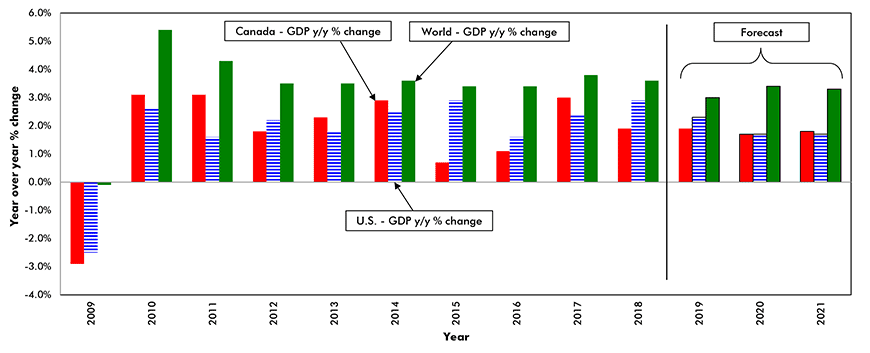World View
The cloud of uncertainty which formed over the global economy in mid-2017 shows no signs of dissipating as the world crosses the threshold into 2020. As noted by the IMF in its World Economic Outlook, “the impact of rising trade and geopolitical tensions has increased uncertainty to levels not seen since the global financial crisis”. The Organization of Economic Cooperation and Development (OECD) echoed this view by stating that “a continued deepening of trade policy tensions… is taking an increasing toll on (business) confidence and investment”.
Both the IMF and the OECD note that the impact of a significant easing of monetary policy in many economies has helped to offset the steep slowdown of international trade and the resultant weakening of investment. Going forward, the effects of persisting low interest rates coupled with sustained growth of employment (mostly in services) have and appear likely to continue to underpin the growth of household incomes and consumer spending.
Neither the IMF nor the OECD expects the geopolitical climate to improve significantly in the near term. The OECD, the IMF and the Bank of Canada expect global growth in the range of 3 to 3.4% in 2020 and 2021. To put these projections in perspective, between 2001 and 2010 global growth averaged 3.9%.
The United States
For some time now, economic pundits on both sides of the Canada/U.S. border have been expecting the U.S. economy to hit the skids. These expectations have intensified against the anemic pattern of global growth. Indeed, Bloomberg just announced a new service, “Recession Watch”, which calculates the probability of a recession in the next twelve months. Currently, it puts that chance at 26%. From our perspective, although there are signs of softening, the U.S. economy still appears to be operating at a healthy pace. For example, the September JOLTs (Job Opening and Labour Turnover survey) indicated that the private sector added staff at the second highest rate on record. Fuelled by the strong pattern of job growth and a steady decline in mortgage rates since late 2018, sales of new homes are up 10% year to date. The Small Business Optimism Index posted a 0.6% m/m rise in October while the National Federation of Independent Business Uncertainty Index fell by four points to 74.
Despite the evidence of underlying strength, several current and forward-looking series reflect the expansion’s advanced age. The Chicago Fed’s National Activity Index dropped to a six-month low of -0.71 in October from -0.45 in September. Also, the Conference Board’s Employment Trends Index and its Index of Help-Wanted Advertising both signaled slower job growth ahead. Finally, the capacity utilization rate declined from 77.3% in December 2018 to 74.7% in October. This suggests that the economy has lost momentum over the past ten months.
Given that the key indicators of U.S. activity are still in positive territory, we expect growth in the U.S. to average in the range of 1.5% to 2.0% in 2020 and 2021 following an estimated gain of 2.3% in 2019.
Canada
Given previous reports of weak exports, few were surprised when Stats Canada announced the economy grew by just 1.3% q/q at an annual rate in the third quarter following a gain of 3.5% in the second quarter. While the headline growth number was weak due to trade, domestic demand rose a very solid 3.1% due in large part to a 13.3% rise in residential construction and a surprisingly strong 9.5% rebound in business non-residential investment.
The outlook for Canada, like that of the U.S., is mixed. On the plus side, year to date, the economy has added 285,000 mostly full-time jobs, 50 per cent more than were added in the first ten months of 2018. According to the Canadian Federation of Independent Business (CFIB), private-sector job vacancies remain at historic highs. Given this momentum, few expect the Bank of Canada to ease further in the near term. However, several indicators paint a darker picture of the outlook. The Bloomberg Nanos Canadian Consumer Confidence Index dropped from 57.8 to 56.7 in October, largely due to a steep post-federal-election decline in the Prairies. At the same time, the CFIB’s measure of small business confidence declined by 4 points. It was also driven lower by a significant erosion of business optimism in the Prairies. Finally, following Q/Q gains of 26.5% in Q1 and 2% in Q2, after-tax profits of non-financial corporations dropped by 22% in Q3. This sharp decline casts a pall over the outlook for investment in 2020.
With three quarters logged in, the consensus estimate is for growth this year to be 1.7%, down from 1.9% in 2018. Looking forward estimates for growth in 2020 and 2021 range from 1.6% to 1.8%.
John Clinkard has over 35 years’ experience as an economist in international, national and regional research and analysis with leading financial institutions and media outlets in Canada.
Global, U.S. and Canadian Gross Domestic Product –
Y/Y % Change












Recent Comments
comments for this post are closed